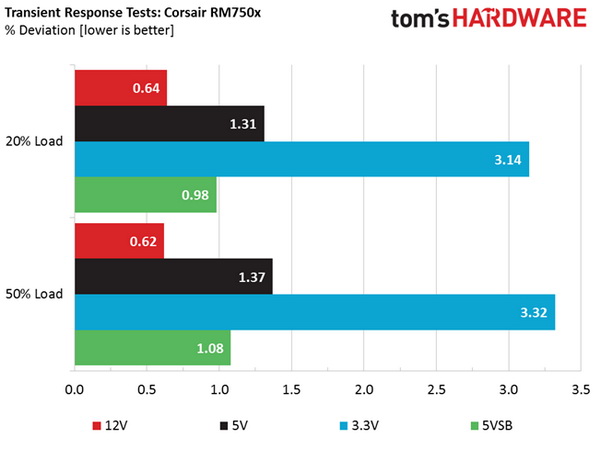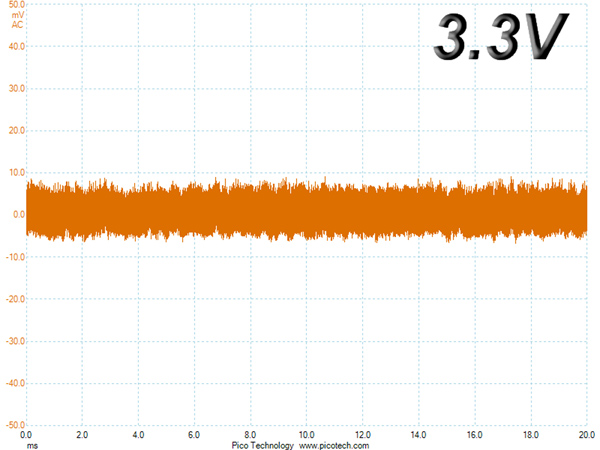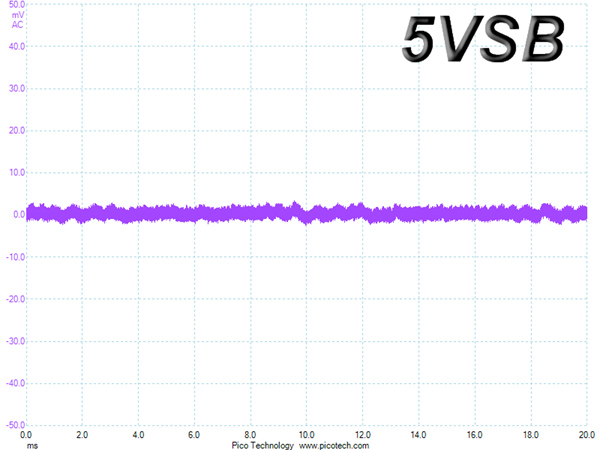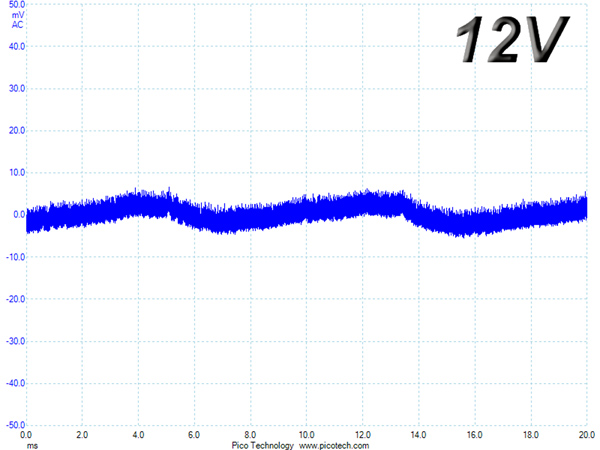Corsair RM750x PSU Review
Corsair released its RMx PSU line, which the company claims will offer good performance along with silent operation. Unlike the RMi models, the RMx units lack a digital interface, a fan test button, and uses a Rifle bearing fan instead of an FDB version.
Why you can trust Tom's Hardware
Transient Response Tests And Ripple Measurements
Advanced Transient Response Tests
For details on our transient response testing, please click here.
In these tests, we monitored the response of the PSU in two different scenarios. First, a transient load (10A at +12V, 5A at 5V, 5A at 3.3V and 0.5A at 5VSB) was applied to the PSU for 200 milliseconds while the PSU was working at 20-percent load. In the second scenario, the PSU was hit by the same transient load while operating at 50-percent load. In both tests, we used our oscilloscope to measure the voltage drops caused by the transient load. The voltages should have remained within the ATX specification's regulation limits.
These tests are crucial because they simulate the transient loads a PSU is likely to handle (such as booting a RAID array, an instant 100-percent load of CPU/GPUs, etc.). We call these tests Advanced Transient Response Tests, and they are designed to be very tough to master, especially for a PSU with a capacity of less than 500W.
Advanced Transient Response at 20 Percent
| Voltage | Before | After | Change | Pass/Fail |
|---|---|---|---|---|
| 12V | 12.048V | 11.971V | 0.64% | Pass |
| 5V | 5.042V | 4.976V | 1.31% | Pass |
| 3.3V | 3.317V | 3.213V | 3.14% | Pass |
| 5VSB | 5.016V | 4.967V | 0.98% | Pass |
Advanced Transient Response at 50 Percent
| Voltage | Before | After | Change | Pass/Fail |
|---|---|---|---|---|
| 12V | 11.984V | 11.910V | 0.62% | Pass |
| 5V | 5.037V | 4.968V | 1.37% | Pass |
| 3.3V | 3.309V | 3.199V | 3.32% | Pass |
| 5VSB | 5.000V | 4.946V | 1.08% | Pass |





The +12V rail behaved very well during these tests, and the 5V and 5VSB rails kept their voltage drops at low levels. On the other hand, the 3.3V rail didn't manage to keep its voltage above 3.2V during the second test, although its deviation was at normal levels (for this rail).
Here are the oscilloscope screenshots we took during the Advanced Transient Response Tests:
Transient Response At 20 Percent Load




Transient Response At 50 Percent Load




Turn-On Transient Tests
In the next set of tests, we measured the response of the PSU in simpler transient load scenarios — during the PSU's power-on phase.
For the first measurement, we turned off the PSU, dialed in the maximum current the 5VSB could output and switched on the PSU. In the second test, we dialed the maximum load the +12V could handle and started the PSU while it was in standby mode. In the last test, while the PSU was completely switched off (we cut off the power or switched off the PSU by flipping its on/off switch), we dialed the maximum load the +12V rail could handle before switching on the PSU from the loader and restoring the power. The ATX specification states that recorded spikes on all rails should not exceed 10 percent of their nominal values (+10 percent for 12V is 13.2V, and 5.5V for 5V).
Get Tom's Hardware's best news and in-depth reviews, straight to your inbox.



A tiny voltage overshoot at the 5VSB rail and two small waves on the waveform before the +12V rails settle down during the last test are nothing to worry about. Overall, the PSU showed good performance here.
Ripple Measurements
To learn how we measure ripple, please click here.
The following table includes the ripple levels we measured on the rails of the RM750x unit. The limits, according to the ATX specification, are 120mV (+12V) and 50mV (5V, 3.3V and 5VSB).
| Test | 12V | 5V | 3.3V | 5VSB | Pass/Fail |
|---|---|---|---|---|---|
| 10 | 5.3 mV | 6.1 mV | 7.3 mV | 20.7 mV | Pass |
| 20 | 5.7 mV | 6.0 mV | 7.5 mV | 4.0 mV | Pass |
| 30 | 6.8 mV | 5.6 mV | 7.8 mV | 4.3 mV | Pass |
| 40 | 7.0 mV | 5.7 mV | 9.8 mV | 5.2 mV | Pass |
| 50 | 7.6 mV | 6.1 mV | 9.6 mV | 6.1 mV | Pass |
| 60 | 8.5 mV | 6.6 mV | 11.2 mV | 6.9 mV | Pass |
| 70 | 9.3 mV | 7.6 mV | 11.9 mV | 8.2 mV | Pass |
| 80 | 10.5 mV | 8.4 mV | 12.8 mV | 10.4 mV | Pass |
| 90 | 11.3 mV | 9.0 mV | 13.6 mV | 10.6 mV | Pass |
| 10 | 13.3 mV | 10.7 mV | 16.9 mV | 11.9 mV | Pass |
| 11 | 14.1 mV | 11.0 mV | 18.3 mV | 12.7 mV | Pass |
| CL1 | 8.0 mV | 9.6 mV | 10.8 mV | 6.9 mV | Pass |
| CL2 | 12.7 mV | 10.7 mV | 16.7 mV | 11.3 mV | Pass |




We saw excellent ripple suppression on all rails. This platform is a great performer, thanks to Corsair's interventions. Besides the high-quality capacitors on the main PCB, the extra capacitors on the ATX, EPS and PCIe cables likely did their part as well.
Ripple Oscilloscope Screenshots
The following oscilloscope screenshots illustrate the AC ripple and noise registered on the main rails (+12V, 5V, 3.3V and 5VSB). The bigger the fluctuations on the screen, the bigger the ripple/noise. We set 0.01V/Div (each vertical division/box equals 0.01V) as the standard for all measurements.
Ripple At Full Load




Ripple At 110-Percent Load




Ripple At Cross-Load 1




Ripple At Cross-Load 2




Current page: Transient Response Tests And Ripple Measurements
Prev Page Efficiency, Temperature, Noise, Cross-Load Tests And Infrared Images Next Page Performance, Performance Per Dollar And Noise Ratings
Aris Mpitziopoulos is a contributing editor at Tom's Hardware, covering PSUs.
-
Blueberries I've been promoting these for a while, it's nice to see Tom's do an article on them. The only reason these are Gold rated is because they just miss the Platinum rating at 20%.Reply
They have a 650x as well that's a little cheaper. -
Amdlova High Rate Faliure can be the the name of this series of corsair. for Now EVGA or SEASONIC power supplies. don't spend a penny on corsair products...Reply -
Aris_Mp Please keep in mind that some Corsair PSUs are also made by Seasonic. Also this series is very new to have a high rate of failures. Unless you have some solid facts to share on the older RM line which is out for quite some time now.Reply -
jonnyguru Reply16801974 said:High Rate Faliure can be the the name of this series of corsair. for Now EVGA or SEASONIC power supplies. don't spend a penny on corsair products...
Wrong on so many levels.
YOU do not have the failure rate for this or any other Corsair PSU.
This PSU is the RMx, not the RM, so even if you did have a failure rate, it would only be about two weeks of data.
If you were talking about the RM and not the RMx, and you actually had failure rate data, you would see that the failure rate on the RM wasn't really high at all.
-
PureBlackFire ReplyHigh Rate Faliure can be the the name of this series of corsair. for Now EVGA or SEASONIC power supplies. don't spend a penny on corsair products...
*sigh* nonsense comment of the day.
-
chalabam Tomshardware:Reply
I don't know if this is a problem of your site, or my PC/IP, but frequently the charts do not load, even when the page "ends" loading.
Sometimes, if I "reload", then the charts also load.
I open all the article pages simultaneously, on different tabs, so I don't need to wait for each one to load. -
Rookie_MIB The older RM units weren't 'bad' really, they were ok, but Corsair has been stepping up its game with quality parts and build on some of these newer units which is nice to see. You can never have too many solidly designed units to choose from - competition toughens the breed.Reply -
Blueberries ReplyHigh Rate Faliure can be the the name of this series of corsair. for Now EVGA or SEASONIC power supplies. don't spend a penny on corsair products...
Did you even LOOK at the article? The only problem with these are the Sinopowers on the secondary side, and that's not even a "bad" thing. Oh and btw, some of the best power supplies in the world are Superflower OEMs produced by Corsair. -
mavikt With these in depth coverage of PSU's I propose introducing a tier'ing table thing at the and of each review (or perhaps a best buy PSU of the month) equivalent to what's done for CPU's and GPU's, ranking PSU models (perhaps too the makers). I saw a comment here on toms on another PSU news flash in the comment section referring to such thing in the forum but now I can't find it.Reply
Permanent'ing such thing from the editorial side would be great! -
Reply
High Rate Faliure can be the the name of this series of corsair. for Now EVGA or SEASONIC power supplies. don't spend a penny on corsair products...
Did you even LOOK at the article? The only problem with these are the Sinopowers on the secondary side, and that's not even a "bad" thing. Oh and btw, some of the best power supplies in the world are Superflower OEMs produced by Corsair.
Corsair doesn't use SuperFlower anywhere in its lineup. CWT, Great Wall, Flextronics, Seasonic and Chicony which has since been dropped are all the OEMs Corsair uses or has used.